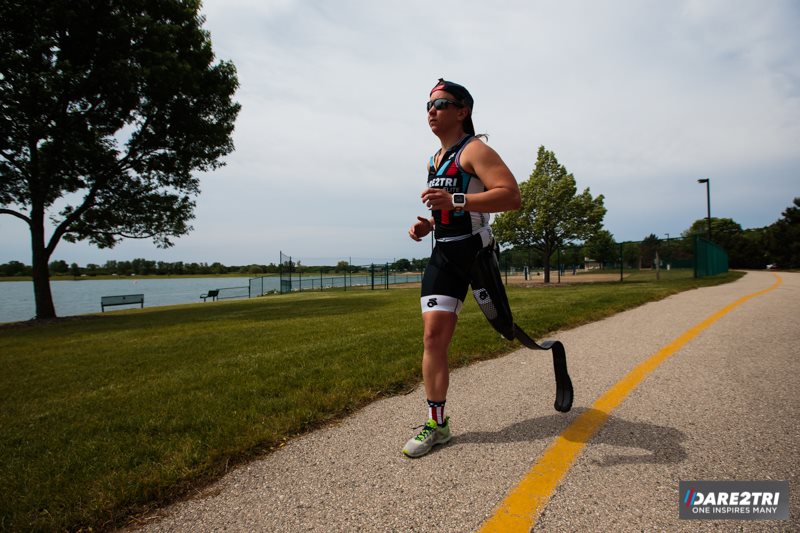National Governing Body- USA Triathlon
International Governing Body- International Triathlon Union


Get Out and TriThank you to Dare2tri for contributing information and photos for this article.
Paratriathlon made its Paralympic competition debut in Rio 2016. The sport, which combines swimming, running and biking into one race, has been rapidly growing in the U.S. and abroad among athletes at all age ranges and ability levels. From 1999 through today, USA Triathlon’s membership has nearly tripled and the number of sanctioned races grew to more than 4,000 last year alone.
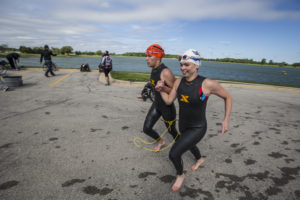 Keri Serota, Executive Director of Dare2tri, a chapter of Disabled Sports USA that focuses solely on paratriathlon, believes that some of the sport’s growth within the adaptive community is the sport’s ability to allow athletes to compete with their peers. “This is truly a community sport,” she said. “One athlete with a disability can race in their own communities with their families and friends without needing to find a team of other athletes like you might with other sports.”
Keri Serota, Executive Director of Dare2tri, a chapter of Disabled Sports USA that focuses solely on paratriathlon, believes that some of the sport’s growth within the adaptive community is the sport’s ability to allow athletes to compete with their peers. “This is truly a community sport,” she said. “One athlete with a disability can race in their own communities with their families and friends without needing to find a team of other athletes like you might with other sports.”
The Four Disciplines
So what exactly is a triathlon? For those that are unfamiliar, a triathlon is a race that starts with a swim, continues with a bike ride and finishes with a run. In between each section of the race is a transition area, where athletes must change their gear and mindset from one sport to the next. The first transition area is where the athlete’s bike, helmet and bike shoes are kept during the swim, and the second area is where the bike is left and any running gear is kept to be utilized for the last let of the race.
Serota recommends that any athlete who wants to become competitive in the sport think of the transition as their ‘fourth discipline’. “Have a specific order for everything you do,” she said. “Do it in the same order every time, even during practice, that way when you get to race day it will be more like second nature.”
I Have to Swim How Far?
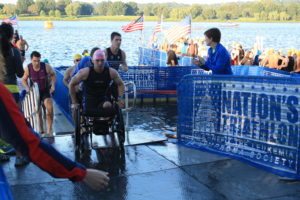 When it comes to selecting your first triathlon, consider your current fitness levels and how long you have to train before race day, then select the distance that is most appropriate. Triathlon comes in a variety of distances to encourage beginners and competitive endurance athletes alike.
When it comes to selecting your first triathlon, consider your current fitness levels and how long you have to train before race day, then select the distance that is most appropriate. Triathlon comes in a variety of distances to encourage beginners and competitive endurance athletes alike.
Youth (7-10) – 100 meter swim, 5 kilometer bike ride, 1 kilometer run
Youth (11-15) – 200 meter swim, 10 kilometer bike ride, 2 kilometer run
Super Sprint– .25 mile swim, 6.2 mile bike ride, 1.6 mile run
Sprint – .5 mile swim, 12.4 mile bike ride, 3.1 mile run
Olympic – .93 mile swim, 24.8 mile bike ride, 6.2 mile run
Half Ironman – 1.2 mile swim, 56 mile bike ride, 13.1 mile run
Ironman – 2.4 mile swim, 112 mile bike ride, 26.2 mile run
Contrary to the name’s implication, the paratriathlon competitors in Rio did not compete at an Olympic distance. The Sprint distance is the Elite Level distance and is utilized for any Paralympic and Paralympic-qualifying races.
Now that you’ve got your equipment and your race picked out, you can make training more fun by connecting with your local Disabled Sports USA Chapter that offers triathlon training.If you cannot find a Dsusa chapter near you, check out the list of US Paralympic clubs that offer triathlon training.
If you’re ready to commit to the sports, Challenged Athletes Foundation, has an annual equipment grant program that might be able to offset some of your costs. They also offer several triathlon camps on the west coast every year.
How Much Equipment Do I Need?As you can imagine, combining three sports into one event might require you to pack a bit more for race day.
Swim – If the water is warm, no special equipment is needed for the swim. If the water temperature drops below 60 degrees, a wetsuit is required. A guide may be required for athletes with visual impairments or those with a lower comfort level with this aspect of the event. Higher-level athletes may consider investing in a triathlon suit, which is a specialized piece of clothing meant to be worn throughout the race to cut down on transition times. The tri suit is thin and breathable and meant to dry quickly so you aren’t uncomfortable during the rest of your race. Swim caps are also standard for triathlons and racers must have their number printed on the cap and visible at all times.
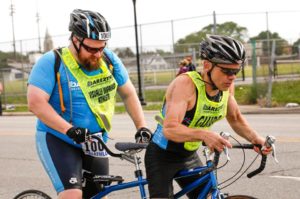 Bike – For this portion of the race, adaptive athletes should use the same piece of cycling equipment they would use for any other bike ride. Handcycles, uprights, tandems and recumbents are all acceptable in smaller, community-based races. Elite competitions have more restrictions on the types of bikes allowed for paratriathletes.
Bike – For this portion of the race, adaptive athletes should use the same piece of cycling equipment they would use for any other bike ride. Handcycles, uprights, tandems and recumbents are all acceptable in smaller, community-based races. Elite competitions have more restrictions on the types of bikes allowed for paratriathletes.
Check your race website to make sure your bike is appropriate for race day. As with any bike ride, you must wear a helmet, and clip in shoes may also be appropriate depending on your riding style and comfort level.
Run – For the run section, wheelchair athletes utilize a push-rim chair. Some races allow handcycles for this section, but you should check your race’s website. Guides are allowed for athletes with visual impairments.
Not having all of the required equipment shouldn’t be a deterrent for registering for your first race. Racers without a racing chair could use another sports chair. Another great option is borrowing equipment for the day. Consider reaching out to your local Disabled Sports USA chapter to see if they can loan you a piece of equipment, or reach out to your local triathlon club to see if they can provide any assistance.
Make it a Team Sport
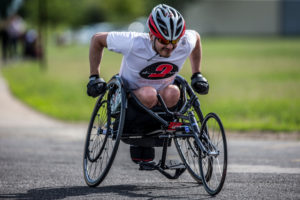 Not comfortable swimming in open water? Don’t have a racing chair yet? Turn your first triathlon into a team sport. More and more races offer a relay option, which is a great way to get introduced to the sport. As in a traditional relay, a different person competes in each discipline. This option allows newer triathletes to compete in a discipline they feel comfortable in, experience the transition area and compete with their friends.
Not comfortable swimming in open water? Don’t have a racing chair yet? Turn your first triathlon into a team sport. More and more races offer a relay option, which is a great way to get introduced to the sport. As in a traditional relay, a different person competes in each discipline. This option allows newer triathletes to compete in a discipline they feel comfortable in, experience the transition area and compete with their friends.
Check the website for the race you’re interested in to see if they offer this option, or reach out to the race director to see if they would allow you to compete as a relay team.
Finding the Perfect Course
Now that you know which distance you want to race, finding a course is a little easier, but with more than 4,300 sanctioned events every year, how do you know which one is right for you? Look for a race that is friendly to adaptive athletes. USA Triathlon certified more than 30 races last year as para-triathlon friendly races. “These are the races you want to be at,” said Serota. They included medal opportunities for adaptive athletes and had shown that they had thought through all of the accommodations necessary for para-triathletes.
 But that doesn’t mean you should rule out a race that hasn’t planned on your participation. “There are very few deal breakers that would make a race not friendly for adaptive athletes,” said Serota.
But that doesn’t mean you should rule out a race that hasn’t planned on your participation. “There are very few deal breakers that would make a race not friendly for adaptive athletes,” said Serota.
She recommends looking for races with paved runs, as they are both wheelchair friendly as well as easier for athletes with lower limb impairments. Also check out both the bike and run paths to see if there are any sharp turns. These can be more difficult for racers using handcycles or tandem bikes and might pose a safety issue. With the swim, adaptive athletes typically start with the first wave, and if the swim is a point to point (starts in one location and ends in another), a reasonable accommodation request is to have someone bring a wheelchair from the entrance point to the exit point, as well as to request a water exit handler. You may also want to request a slightly larger space within the transition areas to include room for two chairs, or a transition assistant if needed. Visually impaired athletes can reasonably expect that their guide be given a free entry slot as the guide is not considered a racer.
To help you think of other accommodations you might need, USA Triathlon has put together an FAQ sheet about paratriathlon and is a good reference for newer athletes who might want to reach out to a race director to see if they would be a good fit for the event.
For a full listing of sanctioned races in the Unites States, visit the USA Triathlon website.
Getting ClassifiedAthletes looking to participate in paratriathlon can break themselves into two categories: Open and Elite.
Open Competition
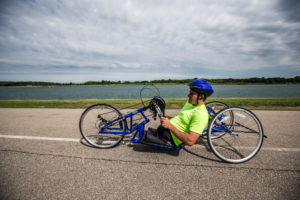 Athletes who are not looking to qualify for Paralympic competition, no matter their fitness or competitive level, fall into the ‘Open’ category. As its name implies, this category is available for all athletes, regardless of whether they have a Paralympic-classifiable disability. The ‘Open’ category also has very few equipment restrictions and allows for more assistance for beginner athletes. For example, racers without their own racing chair could compete in any sports chair in this category, or swimmers with a Traumatic Brain Injury could request a guide during the swim portion of the event, neither of which are allowed within the ‘Elite’ category. Most local races are considered ‘Open’ races as they don’t require a medical classification for their adaptive racers. Instead, medal categories are typically split into ambulatory, blind/visually impaired, and wheelchair athletes.
Athletes who are not looking to qualify for Paralympic competition, no matter their fitness or competitive level, fall into the ‘Open’ category. As its name implies, this category is available for all athletes, regardless of whether they have a Paralympic-classifiable disability. The ‘Open’ category also has very few equipment restrictions and allows for more assistance for beginner athletes. For example, racers without their own racing chair could compete in any sports chair in this category, or swimmers with a Traumatic Brain Injury could request a guide during the swim portion of the event, neither of which are allowed within the ‘Elite’ category. Most local races are considered ‘Open’ races as they don’t require a medical classification for their adaptive racers. Instead, medal categories are typically split into ambulatory, blind/visually impaired, and wheelchair athletes.
Elite Competition
Athletes who have their eyes aimed at the podium need to first get medically classified. An overly simplified view of Paratriathlon classification is as follows:
PTWC – wheelchair athletes
PT2 – severe impairments (typically includes double amputees, above knee amputees, etc.)
PT3 – significant impairments (typically includes severe Cp, hemiplegia, etc.)
PT4 – moderate impairments (typically includes single limb paralysis, MS, Cp, etc.)
PT5 – Mild impairments (typically includes below knee amputees, below elbow amputees, etc.)
PTVI – blind/visually impaired athletes (split into sub classes based on sight levels)
Once classified, athletes competing in the Elite category must follow the specific equipment requirements outlines for their classification category. At the Elite level, only athletes in the Pt 5 category are allowed a guide anywhere on the course. All information about classifications and classification events can be found through USA Triathlon’s website.
Athletes looking to be elite competitors should enter races that have been sanctioned by USA Triathlon as paratriathlon events, and look closely at the 10 different Regional Championships, which typically have a higher competition level. There is no qualification to race in the Regional Championship races.
National Governing Body- USA Triathlon
International Governing Body- International Triathlon Union

